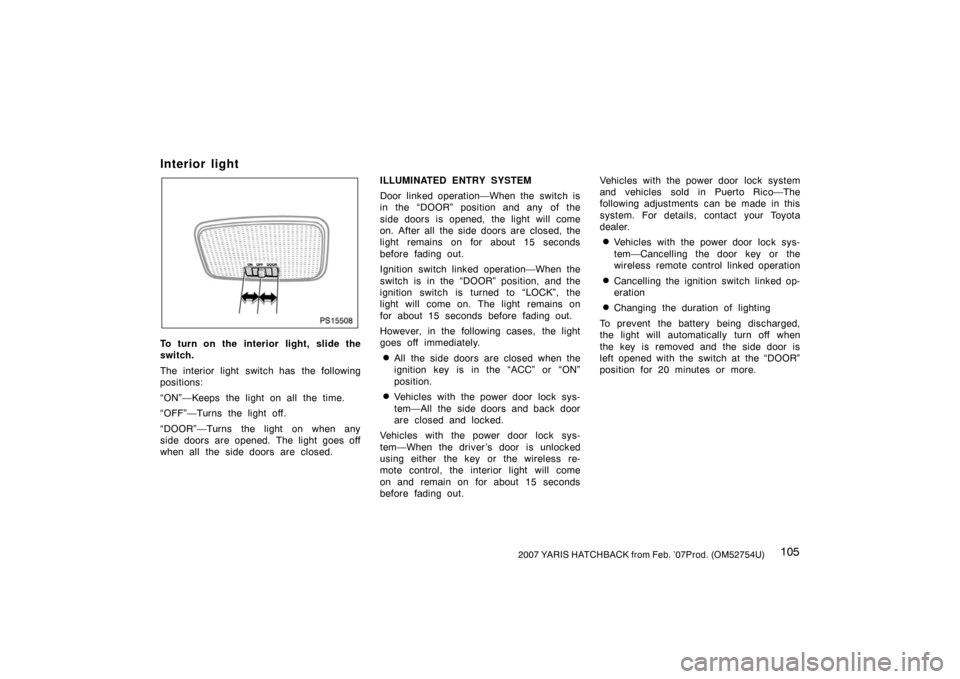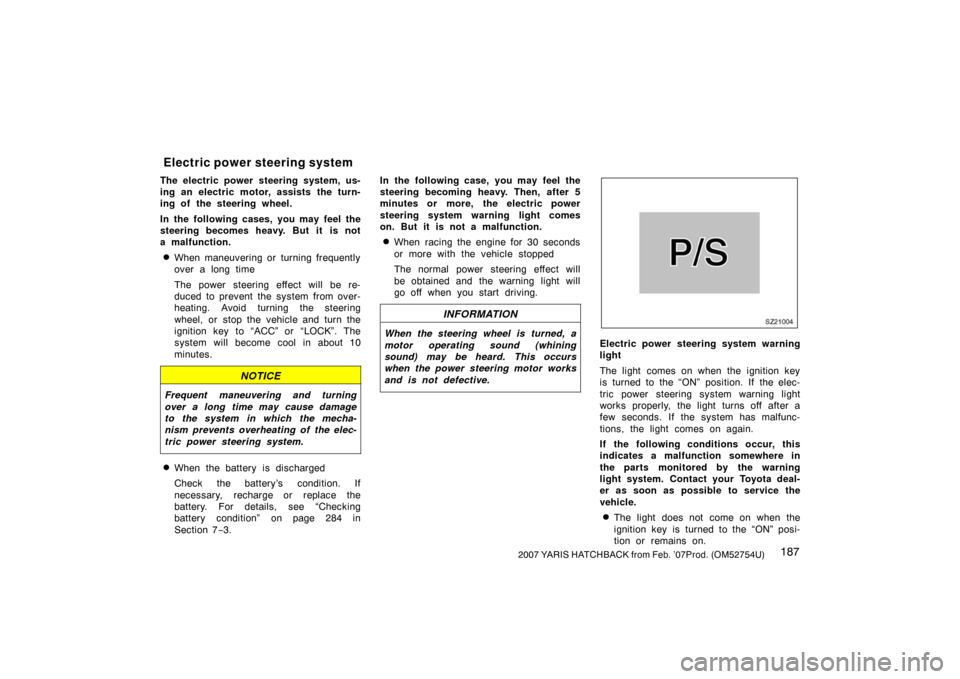Page 112 of 313
1042007 YARIS HATCHBACK from Feb. ’07Prod. (OM52754U)
NOTICE
To prevent the battery from being dis-
charged, do not leave the switch on
longer than necessary when the en-
gine is not running.
Instrument panel light control
PS15506
To adjust the brightness of the instru-
ment panel lights, turn the dial.
With the dial turned fully up, the intensity
of the instrument panel lights will not be
reduced even when the tail lights/head-
lights are turned on.
Front fog lights
PS15507
To turn on the front fog lights, twist
the band of the headlight and turn sig-
nal switch lever. They will come on
when the head lights are on low beam.
Page 113 of 313

1052007 YARIS HATCHBACK from Feb. ’07Prod. (OM52754U)
Interior light
PS15508
To turn on the interior light, slide the
switch.
The interior light switch has the following
positions:
“ON”—Keeps the light on all the time.
“OFF”—Turns the light off.
“DOOR”—Turns the light on when any
side doors are opened. The light goes off
when all the side doors are closed.ILLUMINATED ENTRY SYSTEM
Door linked operation—When the switch is
in the “DOOR” position and any of the
side doors is opened, the light will come
on. After all the side doors are closed, the
light remains on for about 15 seconds
before fading out.
Ignition switch linked operation—When the
switch is in the “DOOR” position, and the
ignition switch is turned to “LOCK”, the
light will come on. The light remains on
for about 15 seconds before fading out.
However, in the following cases, the light
goes off immediately.
�All the side doors are closed when the
ignition key is in the “ACC” or “ON”
position.
�Vehicles with the power door lock sys-
tem—All the side doors and back door
are closed and locked.
Vehicles with the power door lock sys-
tem—When the driver’s door is unlocked
using either the key or the wireless re-
mote control, the interior light will come
on and remain on for about 15 seconds
before fading out. Vehicles with the power door lock system
and vehicles sold in Puerto Rico—The
following adjustments can be made in this
system. For details, contact your Toyota
dealer.
�Vehicles with the power door lock sys-
tem—Cancelling the door key or the
wireless remote control linked operation
�Cancelling the ignition switch linked op-
eration
�Changing the duration of lighting
To prevent the battery being discharged,
the light will automatically turn off when
the key is removed and the side door is
left opened with the switch at the “DOOR”
position for 20 minutes or more.
Page 115 of 313

1072007 YARIS HATCHBACK from Feb. ’07Prod. (OM52754U)
PS15511
To turn on the rear window wiper, twist
the lever knob upward. (Position 1)
The key must be in the “ON” position.
To squirt washer fluid on the rear window,
twist the knob upward or downward as far
as it will go (position 2 or 3). The knob
automatically returns from these positions
after you release it. The rear window wip-
er operates while the washer squirts.
For instructions on adding washer fluid,
see “Adding washer fluid” on page 288 in
Section 7−3.
NOTICE
Do not operate the rear wiper if the
rear window is dry. It may scratch the
glass.
Rear window defogger
PS15512a
To defog or defrost the rear window,
push the switch.
The key must be in the “ON” position.
The thin heater wires on the inside of the
rear window will quickly clear the surface.
An indicator light will illuminate to indicate
the defogger is operating.
Push the switch once again to turn the
defogger off.
Make sure you turn the defogger off when
the window is clear. Leaving the defogger
on for a long time could cause the battery
to discharge, especially during stop −and−
go driving. The defogger is not designed
for drying rain water or for melting snow.
Rear window wiper and washer
Page 116 of 313
1082007 YARIS HATCHBACK from Feb. ’07Prod. (OM52754U)
NOTICE
�To prevent the battery from being
discharged, turn the switch off
when the engine is not running.
� When cleaning the inside of the
rear window, be careful not to
scratch or damage the heater wires
or connectors.
Page 132 of 313

1242007 YARIS HATCHBACK from Feb. ’07Prod. (OM52754U)
Ignition switch
PS17501
“START”—Starter motor on. The key
will return to the “ON” position when
released.
For starting tips, see Section 3.
“ON”—Engine on and all accessories
on.
This is the normal driving position.
“ACC”—Accessories such as the radio
operate, but the engine is off.
If you leave the key in the “ACC” or
“LOCK” position and open the driver’s
door, a buzzer will remind you to remove
the key.“LOCK”—Engine is off and the steering
wheel is locked. The key can be re-
moved only at this position.
You must push in the key to turn the key
from “ACC” to the “LOCK” position. On
vehicles with an automatic transmission,
the selector lever must be put in the “P”
position before pushing the key.
Vehicles with engine immobilizer system—
Once you remove the key, the engine im-
mobilizer system is automatically set. (See
“Engine immobilizer system” on page 13
in Section 1−
2.)
When starting the engine, the key may
seem stuck at the “LOCK” position. To
free it, first be sure the key is pushed all
the way in, and then rock the steering
wheel slightly while turning the key gently.
Approximately five hours after the engine
is turned off, you may hear sound coming
from underneath the luggage compartment
for several minutes. This is normal opera-
tion and does not indicate a malfunction.
(See “Leak detection pump” on page viii.)
It is not a malfunction if the needles on
all meters move slightly when the key is
turned to the “ACC”, “ON” or “START”
position.
CAUTION
For manual transmission:
Never remove the key when the ve-
hicle is moving, as this will lock the
steering wheel and result in loss of
steering control.
NOTICE
Do not leave the key in the “ON”
position if the engine is not running.
The battery will discharge and the
ignition could be damaged.
Page 179 of 313
1712007 YARIS HATCHBACK from Feb. ’07Prod. (OM52754U)
Power outlet
PS10503
The power outlet is designed for power
supply for car accessories. To use the
power outlet, open as shown in the il-
lustration.
The key must be in the “ACC” or “ON”
position for the power outlet to be used.
NOTICE
�To prevent the fuse from being
blown, do not use the electricity
over the total vehicle capacity of
12V/120W.
� To prevent the battery from being
discharged, do not use the power
outlet longer than necessary when
the engine is not running.
�Close the power outlet lid when the
power outlet is not in use. Inserting
anything other than an appropriate
plug that fits the outlet, or allowing
any liquid to get into the outlet may
cause electrical failure or short cir-
cuits.
Glove boxes
PS10504
Upper glove box
PS10505
Lower glove box
Page 195 of 313

1872007 YARIS HATCHBACK from Feb. ’07Prod. (OM52754U)
The electric power steering system, us-
ing an electric motor, assists the turn-
ing of the steering wheel.
In the following cases, you may feel the
steering becomes heavy. But it is not
a malfunction.
�When maneuvering or turning frequently
over a long time
The power steering effect will be re-
duced to prevent the system from over-
heating. Avoid turning the steering
wheel, or stop the vehicle and turn the
ignition key to “ACC” or “LOCK”. The
system will become cool in about 10
minutes.
NOTICE
Frequent maneuvering and turning
over a long time may cause damage
to the system in which the mecha-
nism prevents overheating of the elec-
tric power steering system.
�When the battery is discharged
Check the battery’s condition. If
necessary, recharge or replace the
battery. For details, see “Checking
battery condition” on page 284 in
Section 7 −3. In the following case, you may feel the
steering becoming heavy. Then, after 5
minutes or more, the electric power
steering system warning light comes
on. But it is not a malfunction.
�When racing the engine for 30 seconds
or more with the vehicle stopped
The normal power steering effect will
be obtained and the warning light will
go off when you start driving.
INFORMATION
When the steering wheel is turned, a
motor operating sound (whining
sound) may be heard. This occurs
when the power steering motor works
and is not defective.
SZ21004
Electric power steering system warning
light
The light comes on when the ignition key
is turned to the “ON” position. If the elec-
tric power steering system warning light
works properly, the light turns off after a
few seconds. If the system has malfunc-
tions, the light comes on again.
If the following conditions occur, this
indicates a malfunction somewhere in
the parts monitored by the warning
light system. Contact your Toyota deal-
er as soon as possible to service the
vehicle.
�The light does not come on when the
ignition key is turned to the “ON” posi-
tion or remains on.
Electric power steering system
Page 207 of 313

1992007 YARIS HATCHBACK from Feb. ’07Prod. (OM52754U)
Ti r e relat ed ter mMeaning
Production options weight
the combined weight of those installed regular production options weighing over
2.3 kg (5 lb.) in excess of those standard items which they replace, not pre-
viously considered in curb weight or accessory weight, including heavy duty
brakes, ride levelers, roof rack, heavy duty battery, and special trim
Vehicle capacity weight
(Total load capacity)the rated cargo and luggage load plus 68 kg (150 lb.) times the vehicle’s desig-
nated seating capacity
Intended outboard sidewall
(A) the sidewall that contains a whitewall, bears white lettering or bearsmanufacturer, brand, and/or model name molding that is higher or deeper
than the same molding on the other sidewall of the tire, or
(B) the outward facing sidewall of an asymmetrical tire that has a particular side that must always face outward when mounted on a vehicle
Occupant distributiondistribution of occupants in a vehicle as specified in the third column of Table
1 that follows
Rima metal support for a tire or a tire and tube assembly upon which the tire beads
are seated
Rim diameter (Wheel diameter)nominal diameter of the bead seat
Rim size designationrim diameter and width
Rim type designationthe industry of manufacturer ’s designation for a rim by style or code
Rim widt hnominal distance between rim flanges
Vehicle maximum load on the tirethe load on an individual tire that is determined by distributing to each axle
its share of the maximum loaded vehicle weight and dividing by two